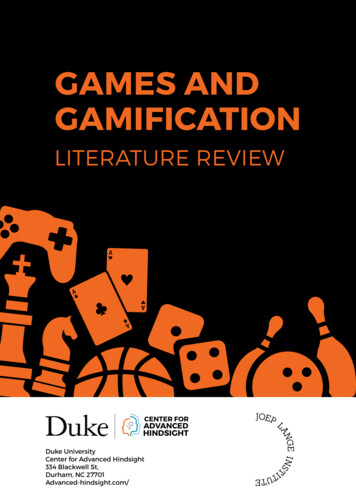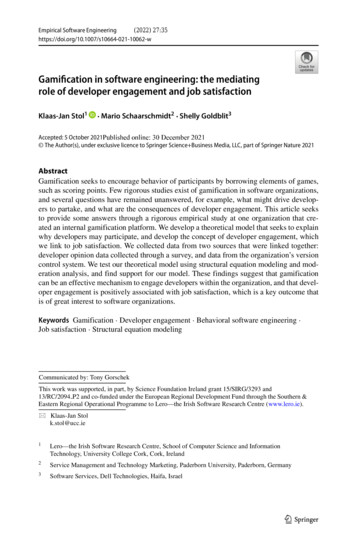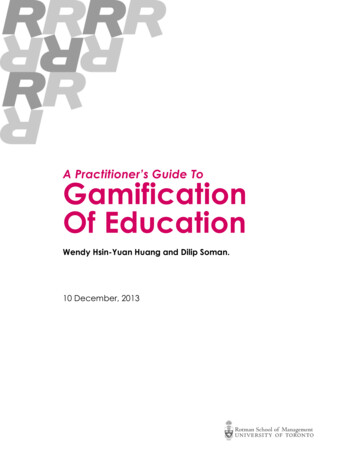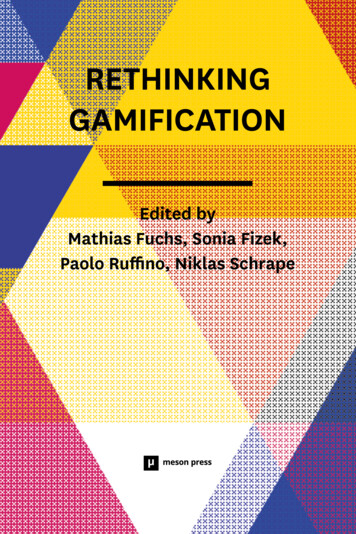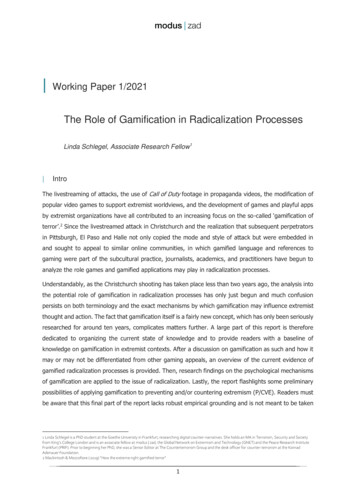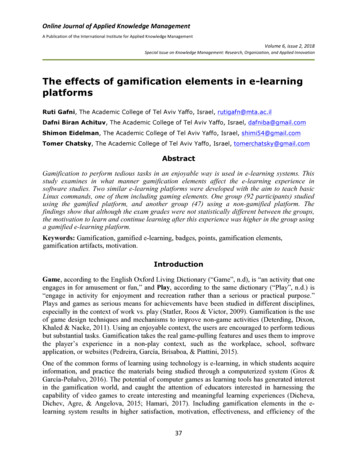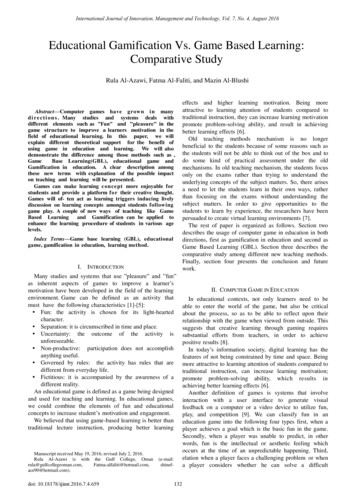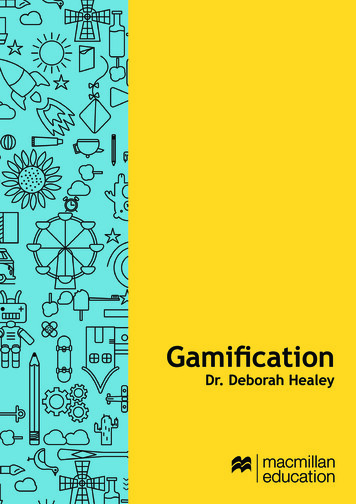
Transcription
GamificationDr. Deborah Healey
Dr.Dr. Deborah HealeyDeborah Healey is the2019-2020 President ofthe Board of Directors of TESOLInternational Association. Shehas taught online and face-toface teacher training coursesfor the University of Oregon,primarily focusing on technologyin education. She gamifiedboth her online and her faceto-face courses. She has alsotaught ESL and EFL at communitycolleges and language institutes.She is a contributor to twoTESOL Technology Standardspublications, as well as the TESOLEncyclopedia of English LanguageTeaching, the Routledge HandbookofLanguageLearningandTechnology, CALL Environmentsand A Handbook for LanguageProgram Administrators. She haswritten and presented extensivelyin the US and internationally,most recently in Uruguay, Tunisia,England, Indonesia, Georgia,Croatia, Serbia, the West Bank,Colombia, Chile, Argentina, andThailand. Her recent areas ofresearch include gamification,massive open online courses,and online teaching approaches.Her doctorate is in Computers inEducation.IntroductionFirst language learning is a natural human process for very young human children in the presence oflanguage users and sufficient language data. Second language learning, sadly, is not so straightforward.In addition to exposure to language users and language data, second language learners work best withstructure and scaffolding and need a reason to make the effort and persist – motivation for time on task.Educators and others have looked at the appealthat games have to induce “flow,” engagement sodeep that time seems to stand still while hours pass.Game designers deliberately incorporate elements– mechanics, dynamics, and emotional appeal – toencourage motivation, time spent in the game, andthe sense of flow. Research in business and now ineducation is exploring how to incorporate gameelements in order to create the same intensityof interest in areas that are not games, hence“gamification.”Nick Pellin first used the term “gamification” in2002 to describe a game-like interface that wouldmake commercial transactions fast and fun. As henotes, he was about 10 years too early. Since itsbroader use began in 2010, “gamification” has beenan increasingly common topic in a range of areas,with gamification of learning increasing in Googlesearches from 2011 on (Google Trends, 2018).The simplest and most widely-used definition ofgamification is “The use of game elements innon-game contexts.” However, a number of otherresearchers and writers prefer the term “gamefuldesign” because of its focus on thoughtful designthat uses game elements (e.g., Deterding, Khaled,Nacke, & Dixon, 2011; McGonigal, 2011; Bell, 2017).This paper will use “gamification” as the morecommon term while keeping in mind the centralelement of design.The paper will begin with defining games anddescribing types of games used in education, thendescribe fundamental elements of gamification.Approaches, psychological underpinnings, andresearch will offer a deeper understanding,concluding with the current state of the art ingameful design in education.Gamification 1
What is a game?Educators have long used gamesin teaching, so it may be usefulto examine a definition of games,then some common types ofgames for teaching and learningin order to contrast them withgamification. According to notedcomputer game creator JaneMcGonigal, “all games share fourdefining traits: a goal, rules, afeedback system, and voluntaryparticipation” (2011: 21). Koster,cited in Kapp, describes a gameas “a system in which playersengage in an abstract challenge,defined by rules, interactivity,and feedback, that results ina quantifiable outcome ofteneliciting an emotional reaction”(Kapp, 2012: 7). So fundamentally,games have a challenge of somesort, rules that people choose tofollow, feedback and interaction,plus an emotional reaction,generally that the game is fun.Players get caught up in a game.Without voluntary participation,it is work. With fun and withoutrules, it counts as “play,” not agame.McGonigal also talks about“hard fun” (2011:32). Challenginggames such as chess are hardfun. These can give players asense of mastery when theysucceed. Simple games that areeasy and that everyone can playsuccessfully are good occasionallyand for short times; the fun doesnot last if the game is too easy. fundamentally,games have a challengeof some sort, rulesthat people choose tofollow, feedback andinteraction, plus anemotional reaction,generally that thegame is fun.Games for learning“S. the game makesrepeated practice muchmore enjoyable thansimple rote learning.erious games” are designedfor something more thanentertainment, such as learningconcepts or skill-based training.Educational games are seriousgames. Concentration using wordsand definitions, an arcade gamewhere players need to shoot theletters in alphabetical order, andspelling bees are all educationalgames. Learning the vocabulary,order of the alphabet, or spellingall make winning the game easier.Players generally focus on theextrinsic motivation of winning,not on intrinsic motivation inlearning. However, the gamemakes repeated practice muchmore enjoyable than simple rotelearning.Most serious games, includingsimulations, are far more complexthan the examples above ofconcentration and arcade gamesfor education. They generallyhave a story that provides thebackground and motivation forlearning. A classic example isCivilization, originally createdin 1991 as a simple computergame. Players need to try toGamification 2
Games for Learning (cont.)create a long-lasting empire by balancing revenueand expenses on a large scale. The game still exists,now in multi-player form. Another current videogame style example is Stop Disasters, from theUnited Nations Office for Disaster Risk Reduction(http://www.stopdisastersgame.org/), where playershave to make choices in order to deal with a varietyof natural disasters such as a tsunami, wildfire, orearthquake. Players learn about risks, plan ways tobuild in order to reduce risk, and see the effects oftheir work when disaster strikes. Gamelearn (n.d.)mentions Dragon Box Elements as a video game whereplayers need to learn geometry to save Euclid’sisland, Pulse! where nurses can practice emergencyroom decision-making, and Pacific, where teambuilding techniques are required in order to escapefrom an island in the middle of the Pacific Ocean. Allof these can also be used in language teaching, sincethey create a reason to collaborate when played inteams and communicate.“Game-based learning” uses a serious gameextensively to achieve an educational purpose. Ineducation, a course unit could be based on a seriousgame such as Civilization, with ancillary materialand attention to the learning coming from the game.Language teachers have used Minecraft, a gamewhere players can collaborate to construct a virtualworld using blocks, for individual, pair, and groupwork. York (2014) describes ways to use Minecraft’screative, adventure, and survival modes to build avariety of language skills. The game is a central partof the activity in game-based learning rather thanan occasional supplement.Fundamental elementsof gamificationD. The most commonlyused elements ingamification in allareas are mechanics:points, badges,and levels.eterding, Dixon, Khaled &Nacke (2011) carefully definegamification as the use of designelements characteristic for gamesin non-game concepts. Theyexplain the difference betweengamification, games, serious games,and play as follows: Gamificationrefers to the use of design elementscharacteristic for games in nongame contexts. The definitiontalks about games as opposed toplay. For the authors, games havecharacteristics that don’t applyto general play, for example,competitive elements and clearlydefined rules. The definition focuseson elements of games. Sometimescomplete games are used in nonentertainmentcontexts,theauthors see this as distinct fromgamification. Gamification useselements, not the whole game.The definition also focuses onthe way games are designedand not on the use of specificgame technologies or practices.Gamification focuses more ondesign features of games such asbadges, levels and leaderboards,which we will examine in moredepth later in this paper.Gamification 3
Fundamental elements of gamification (cont.)Hunicke, LeBlanc, & Zubek (2004)describe three basic principlesof gamification as mechanics(goals, rules, rewards), dynamics(player response to mechanics),and emotions (how players feelabout the experience), referredto as MDA. The most commonlyused elements in gamification inall areas are mechanics: points,badges, and levels. These are partof a reward system with feedback(immediate, if possible) designedto provide positive reinforcementfor performing step-by-step tasksand progressive challenges —following the rules, in other words.Leaderboards that list highestpoint-getters reward success.Competition is a frequently-useddynamic, and leaderboards orother ways of publicly sharingbadges and levels can encouragecompetition. Teamwork or otherforms of collaboration canpromote a different dynamicfrom competition. The gamifiedexperience should feel funand appeal to learners on anemotional level. Many gamifiedenvironments use storytelling toappeal to emotions. Design canaim for certain dynamics andemotions, but those are bothplayer responses that will varyaccording to the individual.Yu-Kai Chou (2014) uses an eightstep approach called “octalysis”to describe a framework for“human-focused design,” hispreferred term for gamification.As he says, “Gamification is thecraft of deriving all the funand engaging elements foundin games and applying themto real-world or productiveactivities. This process is whatI call ‘Human-Focused Design,’as opposed to ‘Function-FocusedDesign.’ It’s a design process thatoptimizes for human motivationin a system, as opposed to pureefficiency.” He identifies eightcore drives in human motivation:in their gamified experiencefor any discipline or targetmarket. Huang & Soman (2013)look specifically at educationand offer a 5-step model forgamifying instruction:1. Accomplishment2. Meaning3. Empowerment4. Ownership5. Social Influence6. Scarcity7. Unpredictability8. Avoidance1. Understand the targetaudience and the context.2. Define learning objectives.3. Structure the experience.4. Identify resources.5. Apply gamification elements. The gamifiedexperience shouldfeel fun and appealto learners on anemotional level. Manygamified environmentsuse storytelling toappeal to emotions.A graphic that includes all of thegame mechanics for each drive isavailable at sis-complete-gamificationframework/.Elements 1, 2 and 3 arepositive motivators. Elements 6,7 and 8 are negative motivators.Ownership and Social influencecan be positive or negative.Good design should take alleight motivators into account.The first two steps are basicto any educational design.Structuringtheexperienceincludes creating the stagesand milestones, which mayeach have their own learningobjectives. In order to be ableto gamify one or more of thepreviously-identified stages, thedesignerhastoidentifyresources. This includes findingtracking mechanisms, settingup the currency (the unit ofmeasurement, such as points),determining levels and howto meet them, setting clearrules for what learners can andcannot do in the environment,andestablishingfeedbackthat shows learner progress.Gamification elements arepersonal/self-elements (badges,levels, time constraints) andsocial (competition, cooperation,sharing achievements). Huang& Soman feel that a “mindfulapproach” using these fiveelements can help lead to asuccessful gamification strategy.Chou’s model can help designersenvision the elements to includeGamification 4
The psychology ofgamificationGamification is based in large part on encouragingmotivation. Intrinsic motivation is the desire toperform an action, such as learning content, for itsown sake. Extrinsic motivation, on the other hand,is responding for a specific, expected reward. Apsychological rationale for the power of intrinsic andextrinsic motivation comes from self-determinationtheory (SDT), proposed by Deci & Ryan (1985a, b).SDT links motivation to behavior, referring to threebasic needs: autonomy, or the feeling of being incontrol; competence, or the sense of buildingskills and developing mastery; and relatedness, orconnection to others. These elements can also befound in Chou’s Octalysis framework as seen in theprevious chapter.According to Deci & Ryan (1985a), the effect ofgame mechanics on motivation depends on howplayers ascribe meaning or “functional significance”to the environmental stimuli. Deci, Koestner,& Ryan (2001) describe this subset of SDT ascognitive evaluation theory, which incorporates anindividual’s perceptions of events. External events,motivators, and environments that increase asense of autonomy and competence can increaseintrinsic motivation. If the events or environmentsseem to be controlling, then intrinsic motivationdecreases. For example, positive feedback thatfeels authentic is good; feedback, even if positive,that seems to be designed to control behavior hasa negative effect (Deci, Koestner, & Ryan, 2001).Gamification is based in large parton encouraging motivation.Research on gamificationResearchongamificationin education has maturedover time from simple surveysof attitudes, generally but notexclusively positive, to a morenuanced view of the way thatdesign affects outcomes fordifferent people. A literaturereview of gamification studiesmostly in higher educationby Dicheva, Dechev, Agre, &Angelova (2015) found that mostof the papers they reviewedshowed encouraging results.Positive results were found interms of higher engagement inlearning activities, increasedattendance, and minimizing thedifference between the highestand lowest scorers. Studies withmixed results seemed to misscritical motivational elementsor were poorly implemented dueto lack of educator time andinteraction with learners.Much of the current researchexplores motivation, includingwillingness to engage andpersistence to achieve time ontask, and efficacy of gamifiedinterventions. A crucial issueGamification 5
Research on gamification (cont.)relates to intrinsic versus extrinsicmotivation. The psychologicalresearch mentioned aboveindicates that a focus on extrinsicmotivation with rewards, whetherpoints or grades, can have anegative effect on performanceonce the reward is reduced oreliminated. Intrinsic motivationcan grow from extrinsic, but it isnot guaranteed. Deci, Koestner,& Ryan point out that “Althoughtangible rewards may controlimmediate behaviors, they havenegative consequences forsubsequent interest, persistence,and preference for challenge,especially for children” (2001:10).In their study, Abramovich,Schunn, & Higashi hypothesizethat “If learners interpret badgesas external rewards, then theycould possibly lower a student’smotivation to learn or cause thestudent to focus on earning badgesto the exclusion of the learninggoals” (2013: 218). They found adifference between the type ofbadge and the type of learner,where participation badges butnot skill badges improvedmotivation for low-performinglearners. High performers weremotivated by skill badges, andthe more badges they had, themore they expected to succeed.Most of the research ongamification in education hasbeen focused on universitystudents, but a few studies havehad children as their focus. Homer,Hew, & Tan (2018) found positiveeffects on children using thegamification platform Class Dojofor oral skills classes in grades 3and 4 compared to students usingtraditional classroom rewards.Students in the gamified classesdid significantly better on preand post-tests. Teachers in thestudy responded that more ofthe class participated and triedharder with Class Dojo thanwith a traditional classroomrewards system. Teachers saidthat even students who were notenthusiastic about badges feltpeer pressure to work harder tokeep up. However, their studyof children in first and secondgrade reading/vocabulary classesshowed no significant differencein pre- and post-test results. Thefirst and second graders did reportthat they enjoyed using ClassDojo and felt it helped them workharder (Homer, et al., 2018). Thestudy by Abramovich, Schunn, &Higashi (2013) cited above waswith 7th and 8th grade mathstudents, where effectivenessof gamification varied withthe type of badge and learner.Jagušt, Botički, & So (2018)researched three configurationsof gamification: competitive,collaborative and adaptive, for2nd and 3rd grade math students.The adaptive condition used anarrative (competing against avirus to solve problems) and anindividually adaptive algorithmthat shortened the time to solveeach problem with each correctanswer. They found the adaptivecondition worked best to sustainstudent performance and had thebest increase in performance.Compared with a non-gamifiedclass, all three gamified conditionsdid better in terms of the numberof problems solved.Compared with a non-gamified class, all threegamified conditions did better in terms of thenumber of problems solved.Gamification 6
Conclusion:Current state of the artGamification has shown thatit can be a valuable additionto designing effective learning.Students tend to like it, and incertain circumstances, it canmotivate and improve learnerperformance. The key is inthe way that gameful design –gamification – is incorporated intoa lesson or a class. Seaborn & Fels(2014) surveyed a range of studiesand conclude that “success mightbe improved across the board ifthe design of gamified systems,especially extrinsic motivators, isinformed by end-users’ intrinsicmotivators. . User-centered designmethodology may help elucidateintrinsic motivators for a givenuser population. There may notbe an ideal gamified system –an optimal combination of gameelements,mechanics,anddynamics that always works –instead, gamified systems mayneed to be selectively designedgiven the individual makeup ofthe end-user population or evendesigned flexibly and inclusively,allowing for personalization andcustomization, to accommodateindividual users” (2014: 28)Similarly, in their overview,Dicheva et al. (2015) concludethat “finding and sharing of newways of applying gamificationto learning contexts that arenot limited to extrinsic rewardslike achievements and badgesand that are more meaningful tothe students is very importantfor increasing the applicationof this emerging technology ineducation. While the concept ofgamification may look simple, theanalyzed work demonstrates thatgamifying learning effectively isnot” (2015: 84). teachers can useknowledge about theirstudents and theircontext plus insightsfrom psychology,research, and gamedesigners to createa meaningful andeffective gamifiedlearning environment.As Chris Jones put it in the titleof his 1989 paper, “It’s not so muchthe program, more what you dowith it.” This is still true. Justadding a few game elements willnot necessarily result in betterlanguage learning. Instead,teachers can use knowledgeabout their students and theircontext plus insights frompsychology, research, and gamedesigners to create a meaningfuland effective gamified learningenvironment.Gamification has shown that it can be avaluable addition to designing effectivelearning. Students tend to like it, and in certaincircumstances, it can motivate and improvelearner performance. The key is in the way thatgameful design – gamification – is incorporatedinto a lesson or a class.Gamification 7
ReferencesAbramovich, S., Schunn, C., & Higashi, R. (2013). Are badges useful in education? It depends upon thetype of badge and expertise of learner. Educational Technology Research and Development, 61, 217–232.Bell, K. (2017). Game on: Gamification, gameful design and the rise of the gamer educator.Baltimore: Johns Hopkins University PressChou, Y.-K. (2014). Actionable gamification: Beyond points, badges, and leaderboards.Milpitas, CA: Octalysis Media.Deci, E. L., & Ryan, R. M. (1985a). Intrinsic motivation and self-determination in human behavior.New York: Plenum.Deci, E. L., & Ryan, R. M. (1985b).The general causality orientations scale: Self-determination in personality.Journal of Research in Personality, 19, 109-134. https://doi.org/10.1016/0092-6566(85)90023-6Deci, E. L., Koestner, R., & Ryan, R. M. (2001).Extrinsic rewards and intrinsic motivation in education: reconsidered once again.Review of Educational Research, 71, 1e27. ng, S., Khaled, R., Nacke, L., & Dixon, D. (2011). Gamification: A definition.Retrieved from a, D., Dichev C., Agre G., & Angelova G. (2015).Gamification in education: A systematic mapping study. Educational Technology & Society, 18 (3), 75–88.Figuera Flores, J.F. (2015) Using gamification to enhance second language learning.Digital Education Review, 27 (June), 32-53.Gamelearn. (n.d.). Eight examples that explain all you need to know about serious games and gamebased learning. Retrieved from rious-gamesgame-based-learning-examples/Google Trends. (2018). Gamification of learning. Retrieved from https://trends.google.com/trends/explore?q %2Fm%2F0 v3k67&date 2004-01-01%202018-12-20Homer, R., Hew, K.F., Tan, C.Y. (2018). Comparing digital badges-and-points with classroom tokensystems: Effects on elementary school ESL students’ classroom behavior and English learning.Educational Technology & Society, 21 (1) 137-151.Huang, W.H.Y. & Soman, D. (2013). A practitioner’s guide to gamification of education.Research Report Series: Behavioral Economics in Action. University of Toronto-Rotman School of Management.Hunicke, R., LeBlanc, M., & Zubek, R. (2004).MDA: A formal approach to game design and game research.Paper presented at the Proceedings of the AAAI Workshop on Challenges in Game AI, San Jose, CA.Gamification 8
References (cont.)Jagušt, T., Botički, I., & So, H-J. (2018). Examining competitive, collaborative and adaptive gamificationin young learners’ math learning. Computers & Education, 125, 444-457.Kapp, K.M. (2012) The gamification of learning and instruction: Game-based strategies for training andeducation. San Francisco: John Wiley.Koster, R. (2005). A theory of fun for game design. Scottsdale, AZ: Paraglyph Press.McGonigal, J. (2011). Reality is broken: Why games make us better and how they can change the world.New York: Penguin Books.Seaborn, K. & Fels, D.I. (2014). Gamification in theory and action: A survey.International Journal of Human-computer Studies, 74, 14-31.York, J. (2014). Minecraft and language learning. Retrieved from Gamification 9
macmillannavio.com
Gamification 1 Introduction First language learning is a natural human process for very young human children in the presence of language users and sufficient language data. Second language learning, sadly, is not so straightforward. In addition to exposure to language users a
